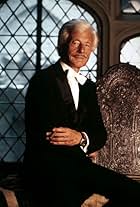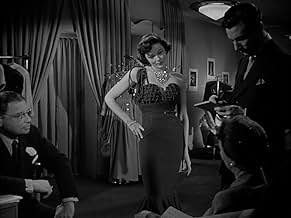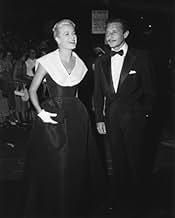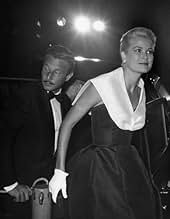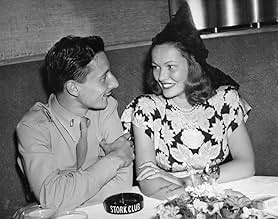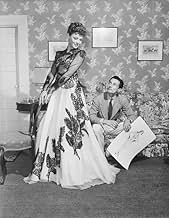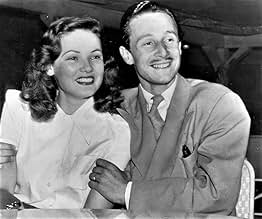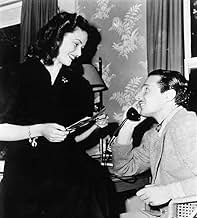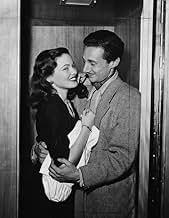Oleg Cassini(1913-2006)
- Costume and Wardrobe Department
- Costume Designer
- Actor
Oleg Cassini Loiewski was born on April 11, 1913, in Paris, France,
into the family of Russian diplomat Alexander Loiewski and Italian
Countess Marguerite Cassini. His maternal grandfather, Arthur Paul
Nicholas, Marquis de Capuzzuchi di Bologna, Count de Cassini, worked
for the Russian Tsar Nicholas II as a diplomat in China and the United States.
Cassini spent his early childhood between Russia and Copenhagen, Denmark, where his father was a diplomat with the Russian Embassy. His family were landed aristocracy in Russia until 1917, when the communists seized their ancestral estate and the family fled to Florence, Italy. There Cassini helped his mother, who worked as a fashion designer of hats at the salon of Countess Fabricotti. He also traveled with his mother to Paris twice a year, where he studied and sketched the new French fashions. In the 1920's-1930's Oleg Cassini studied art at the Academia Belle Arte in Florence under Giorgio De Chirico. In 1933 he opened his own design studio.
He won 5 First Prizes at the 1934 International Fashion Competition in Turin, Italy. There Cassini showed a woman's suit in his famous Cossac-style design featuring huge buttons. He moved to New York in 1936 and then to Hollywood. There he worked first for Paramount Pictures and even designed a sarong for Dorothy Lamour. At that time Cassini was paid $250 a week designing wardrobes for the stars of B movies. In the 40's and 50's he designed costumes for 20th Century Fox and other studios and stars such as Marilyn Monroe, Natalie Wood, Grace Kelly, and Gene Tierney.
Cassini's marriage to Merry Fahrney was brief. Cassini then married Gene Tierney in 1941. As Tierney's parents didn't approve of their union, the couple eloped to Las Vegas, where they used her earrings as wedding rings. He became an American citizen in 1942. He served in the Coast Guard and in the U.S. Cavalry Corps, having become an expert horse rider, and soon earned his lieutenant's bars. After the end of WWII he was discharged and moved back to New York, where he opened the 'Oleg Cassini' Salon on the East 55th Street. In 1950 he played a cameo role of the Fashion Designer to a model, played by his wife, Gene Tierney, in "Where the Sidewalk Ends."
In 1952 Oleg Cassini divorced from Gene Tierney, whose fame grew so much faster, that in Hollywood they began to call him Mr. Gene Tierney. The first of their two daughters was born deaf, due to Tierney's measles infection. Tierney had an affair with then representative John F. Kennedy. Cassini was briefly engaged to Grace Kelly in 1954. She broke their engagement to marry Prince Rainier of Monaco. Before and after his two marriages Cassini was known as a ladies man. He dated actresses Betty Grable, Lana Turner, Ursula Andress among others. He was always seen in the company of starlets, débutantes, heiresses, ingénues, showgirls.
In 1960 Oleg Cassini became the Principal State robe designer chosen by Jacqueline Kennedy, who knew him for years. His solid training in art and his long experience in Hollywood served him well. Cassini created the new image for the First Lady, which became the first memorable fashion line to emerge on TV sets across the world. Cassini's experience with Hollywood cameras gave him the important knowledge of how the clothing would look on the screen, being photographed from a distance. That's how Jacqueline Kennedy's wardrobe was created by Cassini with the emphasis on geometric clarity of lines, pronounced color, sumptuous fabrics, and even the big buttons.
For the President Kennedy's Inauguration in 1961, Cassini dressed the First Lady in a fawn beige wool coat with a small sable collar and a matching pillbox hat. Cassini may have seen pictures of the First Lady of Mexico wearing a pillbox hat a year earlier, but Mrs. Kennedy was the first one to be seen on every TV in the world. Soon, it seemed, women all over the world followed the First Lady's image. In 1963 the world saw another pink pillbox hat by Cassini on Mrs. Kennedy, when she was next to the President when he was assassinated. In less than 3 years Cassini created about three hundred outfits for the First Lady. His creativity was inspired by Russian, Italian, French, Oriental, and Native American cultures.
Cassini is credited for such design accomplishments as the sheath, the A-line, the little white collar dress, the knit, and the military look for women. He claimed credit for introducing the Nehru Jacket in 1966-67, based on a traditional Indian jacket and named after the Indian Prime Minister Jawaharlal Nehru. Cassini also designed a Johnny Carson line of men's suits. In 1980's Cassini began to lose the public attention. He enjoyed a comeback in 2001, when he introduced the Oleg Cassini Sport line, alluding to his designs and color-schemes of the 60's. He also had a successful bridal business and about 40 licensees across the world. His collection of Jacqueline Kennedy's dresses was displayed at the Metropolitan Museum of Art in 2001. Some pieces of her wardrobe were sold at auction houses.
Oleg Cassini died on March 17, 2006, on Long Island, New York, where he had an Oyster Bay home, previously owned by the Tiffany family. He was arguably the oldest famous fashion designer in the world.
Cassini spent his early childhood between Russia and Copenhagen, Denmark, where his father was a diplomat with the Russian Embassy. His family were landed aristocracy in Russia until 1917, when the communists seized their ancestral estate and the family fled to Florence, Italy. There Cassini helped his mother, who worked as a fashion designer of hats at the salon of Countess Fabricotti. He also traveled with his mother to Paris twice a year, where he studied and sketched the new French fashions. In the 1920's-1930's Oleg Cassini studied art at the Academia Belle Arte in Florence under Giorgio De Chirico. In 1933 he opened his own design studio.
He won 5 First Prizes at the 1934 International Fashion Competition in Turin, Italy. There Cassini showed a woman's suit in his famous Cossac-style design featuring huge buttons. He moved to New York in 1936 and then to Hollywood. There he worked first for Paramount Pictures and even designed a sarong for Dorothy Lamour. At that time Cassini was paid $250 a week designing wardrobes for the stars of B movies. In the 40's and 50's he designed costumes for 20th Century Fox and other studios and stars such as Marilyn Monroe, Natalie Wood, Grace Kelly, and Gene Tierney.
Cassini's marriage to Merry Fahrney was brief. Cassini then married Gene Tierney in 1941. As Tierney's parents didn't approve of their union, the couple eloped to Las Vegas, where they used her earrings as wedding rings. He became an American citizen in 1942. He served in the Coast Guard and in the U.S. Cavalry Corps, having become an expert horse rider, and soon earned his lieutenant's bars. After the end of WWII he was discharged and moved back to New York, where he opened the 'Oleg Cassini' Salon on the East 55th Street. In 1950 he played a cameo role of the Fashion Designer to a model, played by his wife, Gene Tierney, in "Where the Sidewalk Ends."
In 1952 Oleg Cassini divorced from Gene Tierney, whose fame grew so much faster, that in Hollywood they began to call him Mr. Gene Tierney. The first of their two daughters was born deaf, due to Tierney's measles infection. Tierney had an affair with then representative John F. Kennedy. Cassini was briefly engaged to Grace Kelly in 1954. She broke their engagement to marry Prince Rainier of Monaco. Before and after his two marriages Cassini was known as a ladies man. He dated actresses Betty Grable, Lana Turner, Ursula Andress among others. He was always seen in the company of starlets, débutantes, heiresses, ingénues, showgirls.
In 1960 Oleg Cassini became the Principal State robe designer chosen by Jacqueline Kennedy, who knew him for years. His solid training in art and his long experience in Hollywood served him well. Cassini created the new image for the First Lady, which became the first memorable fashion line to emerge on TV sets across the world. Cassini's experience with Hollywood cameras gave him the important knowledge of how the clothing would look on the screen, being photographed from a distance. That's how Jacqueline Kennedy's wardrobe was created by Cassini with the emphasis on geometric clarity of lines, pronounced color, sumptuous fabrics, and even the big buttons.
For the President Kennedy's Inauguration in 1961, Cassini dressed the First Lady in a fawn beige wool coat with a small sable collar and a matching pillbox hat. Cassini may have seen pictures of the First Lady of Mexico wearing a pillbox hat a year earlier, but Mrs. Kennedy was the first one to be seen on every TV in the world. Soon, it seemed, women all over the world followed the First Lady's image. In 1963 the world saw another pink pillbox hat by Cassini on Mrs. Kennedy, when she was next to the President when he was assassinated. In less than 3 years Cassini created about three hundred outfits for the First Lady. His creativity was inspired by Russian, Italian, French, Oriental, and Native American cultures.
Cassini is credited for such design accomplishments as the sheath, the A-line, the little white collar dress, the knit, and the military look for women. He claimed credit for introducing the Nehru Jacket in 1966-67, based on a traditional Indian jacket and named after the Indian Prime Minister Jawaharlal Nehru. Cassini also designed a Johnny Carson line of men's suits. In 1980's Cassini began to lose the public attention. He enjoyed a comeback in 2001, when he introduced the Oleg Cassini Sport line, alluding to his designs and color-schemes of the 60's. He also had a successful bridal business and about 40 licensees across the world. His collection of Jacqueline Kennedy's dresses was displayed at the Metropolitan Museum of Art in 2001. Some pieces of her wardrobe were sold at auction houses.
Oleg Cassini died on March 17, 2006, on Long Island, New York, where he had an Oyster Bay home, previously owned by the Tiffany family. He was arguably the oldest famous fashion designer in the world.
